|
Limitar tu búsqueda
[+–] Compilador o editor
- Aguilera, Nelly (6)
- Durán, Luis (5)
- Garro, Nora (1)
- Hernández Sánchez, José Antonio (1)
- Martínez, Gabriel (3)
- Meléndez, Jorge (1)
- Palmero Zilveti, Olga (2)
- Reyes Godelmann, Iker (2)
- Suárez, Rosa María (1)
- Valencia, Anel (1)
[+–] Editorial
[+–] Fecha
[+–] Formato
[+–] Idioma
[+–] Tipo de documento
[+–] Tipo de recurso
[+–] Classification
|

|
|
Feasibility analysis of an integrated health system: financial and distributive implications
The document presents spending projections and projections of the distributive incidence for an Integrated Health System under three basic scenarios: status quo, a two pillar scheme (financed through general taxes and private spending) and a three pillar scheme (financed through general taxes, social security contributions and private spending). By presenting these simulations, the study enhances...
|
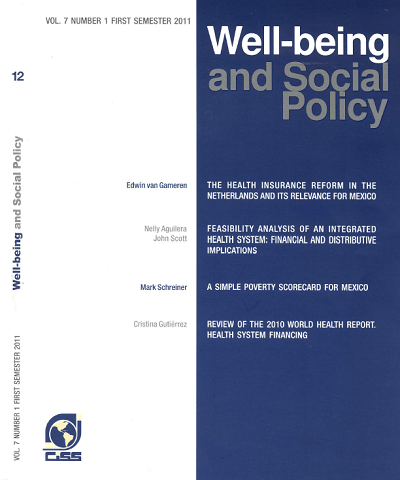
|
|
|
|

|
|
The health insurance reform in the Netherlands and its relevance for Mexico
Alrededor del mundo se observan dos versiones de la organización de los seguros de salud; la seguridad social basada en el empleo, y los servicios nacionales de salud. En Latinoamérica regularmente se usa la primera, pero se está lejos de lograr la cobertura universal. En los Países Bajos encontramos una peculiar mezcla de obligaciones públicas y responsabilidades privadas. La cobertura universal...
|

|
|
|
|

|
|
Book review. Violence and social orders: a conceptual framework for interpreting recorded human history, by Douglas C. North, John Joseph Wallis, and Barry R. Weingast
Why societies differ in their level of violence? This is the question addressed by North, Wallis, and Weingast. To provide an answer they must develop a rich theory of how individuals and organizations that compose a human group voluntarily surrender their will to act violently in exchange for participating in a society with improved conditions for the creation and conservation of wealth.
|
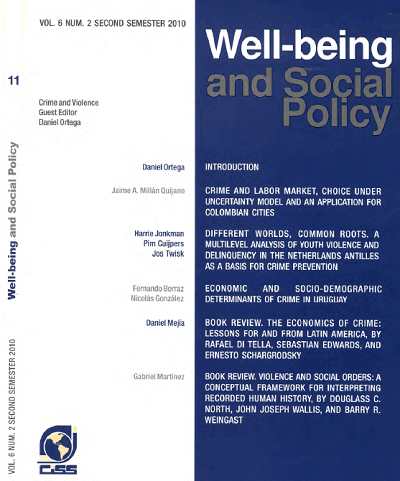
|
|
|
|

|
|
Book review. The economics of crime: lessons for and from Latina America, by Rafael Di Tella, Sebastian Edwards, and Ernesto Schargrodsky
The Economics of Crime: Lessons for and from Latin America makes an important contribution to the study of crime and violence in Latin America and to the debate about what works for reducing crime (and at what cost?). As the title of the book correctly suggests, the book brings together contributions from Latin American economists on the determinants and consequences of crime, as well as...
|
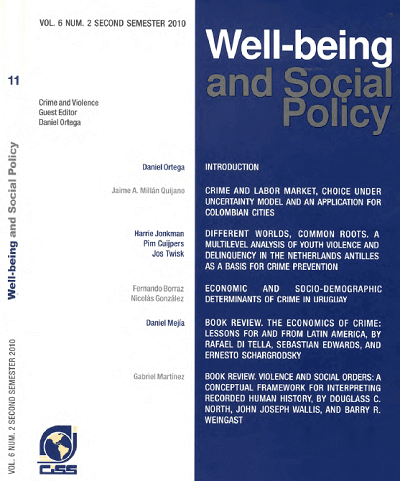
|
|
|
|

|
|
Economic and socio-demographic determinants of crime in Uruguay
This study estimates a panel data model to analyze the economic and socio-demographic determinants of crime in Uruguay across the 19 Uruguayan departments in the period 1986-2006.
This research has two components: i) to present a systematic analysis of the Uruguayan crime data and socio-economic and demographic characteristics of the population, and ii) to evaluate the empirical significance...
|
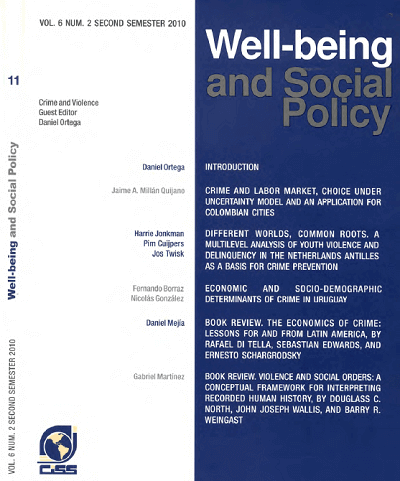
|
|
|
|

|
|
Different worlds, common roots a multilevel analysis of youth violence and delinquency in the netherlands antilles as a basis for crime prevention
Most research on the prevalence, determinants, and variations of violence and delinquency among youngsters is conducted in Western societies. This multilevel study is set in the Netherlands Antilles (NA) and aims to build up prognostic multilevel models as a basis for targeted crime prevention in a non-western area. Data were collected from a sample of adolescente in the NA. Non-hierarchical and...
|
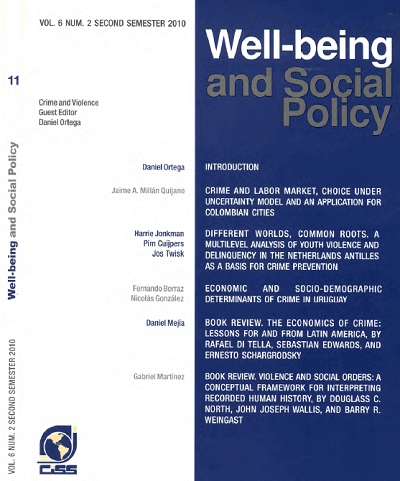
|
|
|
|

|
|
Crime and labor market, choice under uncertainty model and an application for colombian cities
Este trabajo ofrece un modelo para determinar la función de oferta del crimen con base en la teoría de la elección en condiciones de incertidumbre. Con base en el problema de un agente que maximiza su utilidad sujeto a las restricciones del mercado legal e ilegal, este estudio intenta explicar la oferta de la delincuencia como función de la distribución de los salarios y el equivalente cierto de...
|
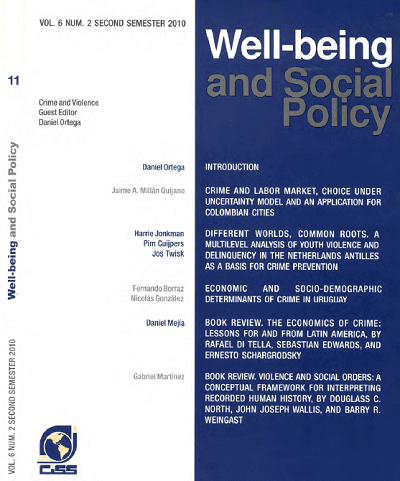
|
|
|
|

|
|
Introduction (On the studies presented at the International Conference on "Delinquency and Violence in Latin America and the Caribbean")
Crime has become the leading concern for citizens of the region and has been pushed to the forefront of the international policy agenda; what is more, the combination of very few success stories and abundant failures in curbing crime and violence has underscored how thin our understanding is and the difficulty of designing and implementing an effective strategy at the local level. This issue...
|

|
|
|
|

|
|
Protecting vulnerable children from uninsured risks: adapting conditional cash transfer programs to provide broader safety nets
Conditional cash transfer (CCT) programs have proved to be effective in inducing chronic poor households to invest in the human capital of their children while helping reduce poverty. They have also protected child human capital from the shocks that affect these households. In this paper, we argue that many non-poor households exposed to uninsured shocks have to use children as risk coping...
|
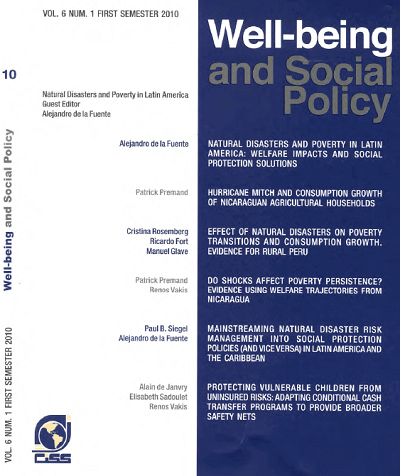
|
|
|
|

|
|
Mainstreaming natural disaster risk management into social protection policies (and vice versa) in Latina America and the Caribbean
This paper presents and applies the social risk management (SRM) conceptual framework to examine links between disaster risk, hazards, vulnerability, risk management, and social protection (SP). The paper makes the case that it is important to mainstream social protection policies into the disaster risk management (DRM) agenda and, vice versa as a means to improve household and community...
|
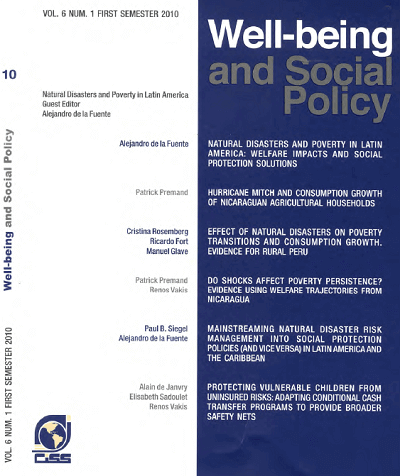
|
|
|
|

|
|
Book review. New structural economics de Justin Yifu Lin
The international financial crisis of 2008-2009, its impact on economic activity and contrasting I responses to face it have given new impetus to the debate Between academics, international organization representatives and public officers on the scope for public policies to reduce the adverse impact of externa) shocks and trigger sustainable long-term growth in production and employment. The...
|
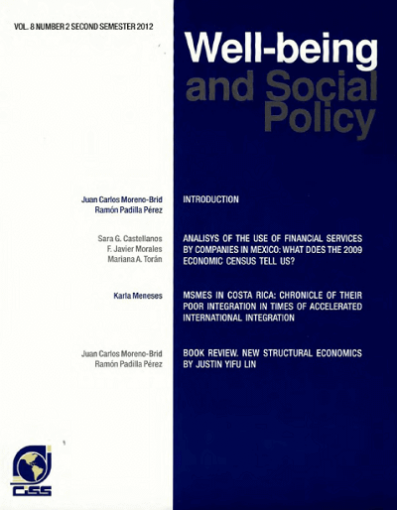
|
|
|
|

|
|
A quantitative analysis of social capital in Mexico
Se ha relacionado el capital social a la eficiencia en los mercados (Arrow, 1972), al refuerzo del contrato (Durlauf y Fafchamps, 2004) y en general al desarrollo y bienestar (Keefer y Knack 1997; Putnam 2000; Knack y Zak 2003). En el presente trabajo hemos investigado los determinantes del capital social empíricamente, centrándose en tres medidas comunes aproximadas de este: dos ligadas a la...
|

|
|
|
|

|
|
Orientaciones de la seguridad social en América Latina
La búsqueda de la seguridad, individual, familiar y colectiva, ha sido siempre uno de los instintos históricos básicos de la humanidad, desde sus primeros tiempos. Clanes, tribus, hordas, imperios, fraternidades, órdenes, guildas, clases, sindicatos, asociaciones de toda índole, han reflejado en la historia, a través de los tiempos, el egoísmo individualista y la solidaridad Colectivista, que...
|

|
|
|
|

|
|
Acta de la XXXV Reunión del Comité Permanente Interamericano de Seguridad Social
Contenido: Participantes. Primera sesión. Presídium y quorum. Acta de la XXXIV Reunión del CPISS. Informe 1991 de la Secretaria General de la CISS. I. Introducción. II. Acción del CIESS. III. Cooperación Técnica Horizontal. IV. Sistema de Información de la Seguridad Social Americana (SISSA). V. Ingreso de Nuevos Miembros. VI. Relación con otros Organismos. VII. Publicaciones. VIII. Situación...
|
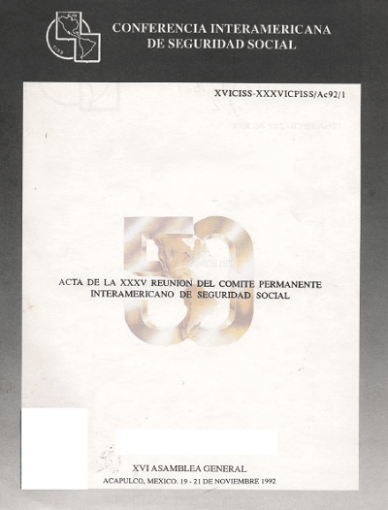
|
|
|
|

|
|
Palabras de introducción
Palabras de introducción al primer número de la Revista de Seguridad Social que se publica bajo los auspicios conjuntos, de la Asociación Internacional de Seguridad Social y la Conferencia Interamericana de Seguridad Social.
|

|
|
|
|

|
|
Informe final primera reunión: del 31 de octubre al 4 de noviembre de 1994, REDEFS
Contenido: Introducción. Objetivos. Misión de la REDEFS. Informe final. Anexo 1. Relación de participantes. Anexo 2. Programa de la Reunión. Anexo 3 Formato de registro. Anexo 4 Conclusiones y propuestas para el Programa Operativo de la REDEFS. Anexo 5 Agenda de Economía de la Salud para A.L. y el Caribe / Rocío Santoyo-Vistrain y André César Medici. Anexo 6 Perspectivas de la Investigación en...
|
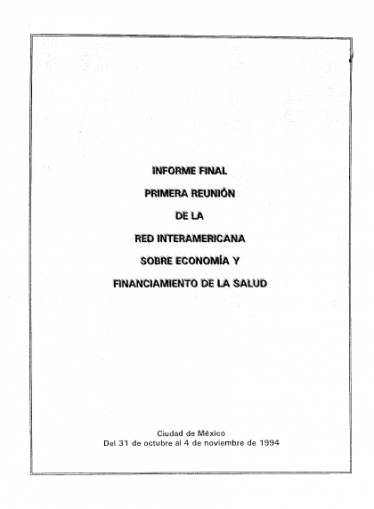
|
|
|
|

|
|
1a reunión Informe final de la RED Interamericana sobre Economía y Financiamiento de la Salud REDEFS
Contenido: Introducción. Objetivos. Sesiones Plenarias y Mesas de Trabajo. 1. Campos de la economía de la salud en el proceso de reforma del sector salud. a) Agenda de economía de la salud para América Latina y el Caribe / Rocío Santoyo Vistrain. b) Contribución de la economía de la salud a la solución de los problemas de la política de salud a cargo / Joan Rovira. c) La economía de la salud y...
|

|
|
|
|

|
|
Una nueva estructura de la seguridad social: trabajos de la primera Conferencia Interamericana de Seguridad Social, Santiago de Chile, 10 al 16 de septiembre, 1942
Contenido: Organización de la Conferencia. Composición. Participación de la OIT. Orden del día. Discursos inaugurales. Seguro para los trabajadores agrícolas, independientes y personal doméstico. Eficacia y economía de las prestaciones médicas y farmacéuticas. Funcionamiento de las pensiones de invalidez. Sistema uniforme de bioestadísticas sobre bases etiológicas. Resoluciones diversas.
|
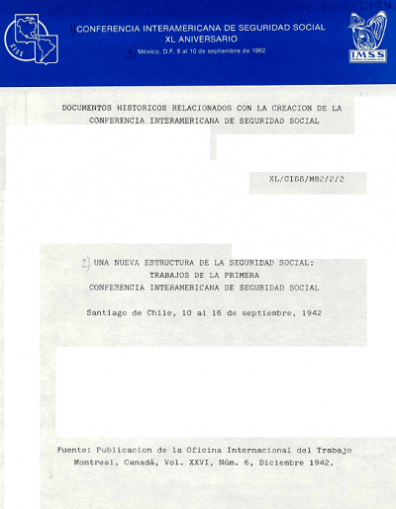
|
|
|
|

|
|
XXVIII Asamblea General Ordinaria de la CISS. Programa
Contenido: Seminario: La seguridad social en América a debate: hacia una agenda hemisférica 2030. Mesas temáticas. Participación durante el almuerzo. Ponentes. Programa general. Información general. Recomendaciones generales. Directorio de embajadas.
|

|
|
|
|

|
|
Análisis de la gestión del sistema de pensiones mexicano en la transición
El sistema de pensiones mexicano, basado en la capitalización individual, entró en vigor el 1 de julio de 1997. A cuatro meses de la puesta en marcha del nuevo modelo, en este trabajo se presenta la situación en lo que se refiere a: la confianza en el nuevo sistema de pensiones; la cobertura del mercado; la capacidad de las AFORES para mantener a sus afiliados; la actualización del marco...
|
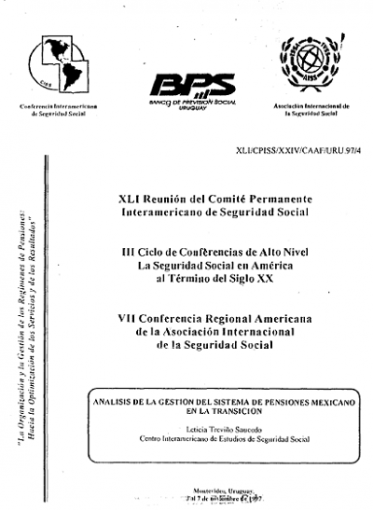
|
|
|
|
|